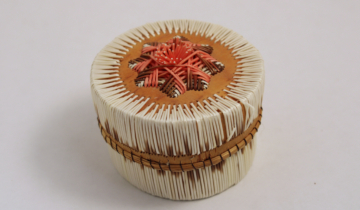The concept of “tourist art” is inescapable in a place like MCML. While this may seem like a neutral term, art made for tourists, in the art world it comes with the negative connotations of ‘cheap’, ‘cash grab’ or ‘inauthentic’. And yes, any traveller can tell you there are shops that advertise local craft items but offer mass-produced replicas. They are not the subject of this conversation. When it comes to craft produced by real artisans this label of “tourist art” has consequences, namely it devalues the work and marginalizes the makers. The label tourist art disproportionately affects non-western artisans that live in colonized communities.
These issues are rooted in the invention of the “Primitive Other”, a rhetorical device created as a tool of colonization. Populations that were being targeted were deemed to be people living in undeveloped, simple, and unsophisticated societies. Not only was this a way to other and dehumanize those being colonized but it also helped the individuals settling the land and committing violence by creating a justification for their actions. These myths of primitivism went hand in hand with other colonial tools like assimilation, the erosion of traditional teachings and language, and the myth that Indigenous peoples around the world were “doomed” or “dying” races.
In Europe, during the colonial period, the material culture of these “dying races” became a public fascination, it was collected en masse by the rich and this interest bled into the art market and museum world to the point where Primitivism became its own artistic movement. This market benefits greatly from the idea of rarity.
On the flip side, we have the artisans themselves who are selling their wares to tourists to survive, now that their way of life has been destroyed. Tourists in turn love the opportunity to collect these works like their wealthy counterparts but it is a detriment to the market if the arts survive and are being sold to anyone at a reduced price.
At the turn of the 20th century we can see the development of a distinction between capital ‘a’ Art and tourist art. This attitude has a particular fixation on originality as a tool to devalue work and the line between “fake” and “inauthentic” is blurred to near obscurity. Within this framework, the level of craft excellence is incidental. For example, quillwork takes hours to make and years to perfect no matter the market it is being produced for. Additionally, many contemporary Indigenous artists working in new media today have to deal with questions of inauthenticity if their work incorporates anything but traditional materials.

Small Quillwork container, maker unknown, c. 1960
Today many workers in cultural institutions still hold these beliefs and the “Primitivism” market is still alive and well. These attitudes have been particularly difficult for craft historians and writers to shake; I believe in large part due to the fact that the Primitivism Movement has always elevated craft in ways the mainstream art movements haven’t.
MCML’s has taken steps to research and bolster the stories of work in the collection that has previously been dismissed as “tourist art”. While it is unlikely our research will result in the identification of individual craftspeople/artists, many of the Canadian Indigenous works in the collection have been narrowed down to their Nation of origin. Hopefully, as research progresses we can continue to expand these stories.
Written by Sonia Gaiess, MCML Collections Management Assistant 2022-2023.
Funding for this blog post was provided in part by the Community Museums Project Grant (Province of Manitoba).



